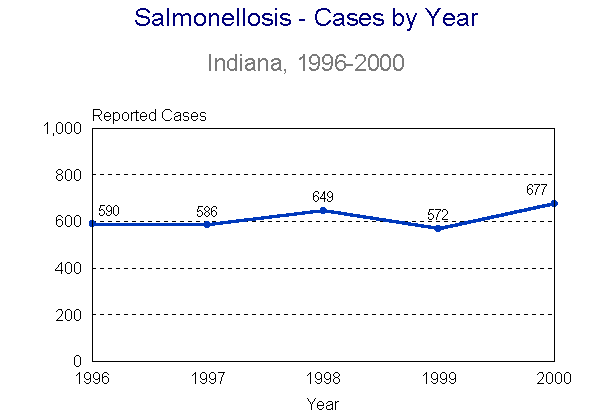Figure Sal1: Salmonellosis Cases by Year, Indiana, 1996-2000

2000 Indiana Report of Infectious Diseases |
View ISDH's Quick Facts on Salmonella
View CDC's Salmonella page
Rates presented are per 100,000 population and are based on the U.S. 2000 Census.
| Cases | Incidence Rate |
|
| Total | 677 | 11.1 |
| Race-specific cases and rates1 | ||
| White | 415 | 7.8 |
| Black | 43 | 8.4 |
| Other2 | 5 | *2.0 |
| Sex-specific cases and rates3 | ||
| Female | 373 | 12.0 |
| Male | 300 | 10.1 |
Salmonellosis is a bacterial disease usually transmitted through raw or undercooked foods of animal origin or foods cross-contaminated by animal products or feces. It can also be transmitted person-to-person. Reservoirs include poultry, swine, cattle, rodents, reptiles, and wild birds such as ducks and geese.
The incidence of salmonellosis in Indiana increased from 572 reported cases in 1999 to 677 (Figure Sal1). This incidence is the highest yearly incidence from 1996-2000. The incidence was greatest during the late summer months (Figure Sal2).
Blacks (8.4 cases per 100,000 population) were slightly more likely to become infected with Salmonella than whites (7.8). Overall age-specific rates were greatest among infants (54.4) followed by preschoolers (30.1) (Figure Sal3). Among counties with at least 5 reported cases, crude incidence rates of salmonellosis were greatest in Montgomery (47.8), Adams (35.7), White (31.7), Monroe (23.2), and Porter (21.8) Counties.
There are over 2,300 different Salmonella serotypes that differ in somatic and flagellar antigens. The Indiana State Department of Health requests that clinical laboratories submit all positive Salmonella isolates to the ISDH Laboratories for free confirmation and serotyping. During 2000, serotypes were determined for 86% of the reported Salmonella cases. Figure Sal4 shows the distribution of Salmonella serotypes from initial and reference specimens submitted to the ISDH Enterics Laboratory. Of the 580 Salmonella isolates of known serotype, 149 (26%) were typhimurium (including 21 that were Copenhagen variant), 147 (25%) were enteritidis, 47 (8%) were heidelberg, 39 (7%) were newport, 20 (3%) were java, 20 (3%) were berta, and the remaining 158 (27%) were other serotypes.
The ISDH investigated one suspected and one confirmed outbreak of salmonellosis in 2000. In March, at least 23 people became ill with gastroenteritis at a local elementary school in Marshall County. Statistical analysis revealed that pork sausage served at the school lunch on March 21 was the only food vehicle significantly associated with illness. No food or stool samples were available for testing. However, the clinical syndrome was most compatible with Salmonella. Food poisoning due to this agent is usually attributed to inadequate cooking, particularly of poultry and eggs, temperature abuse, and cross-contamination of foods. Several instances of temperature abuse of the sausage were noted. No food workers were ill prior to the outbreak, and no evidence of mishandling was noted, reducing the likelihood of a viral cause.
From September 2 to September 26, 2000, 13 culture-confirmed cases of Salmonella berta were identified in Montgomery County. Although first thought to have occurred at Wabash College, this outbreak actually involved the larger community of Crawfordsville. The exact food source or vehicle could not be conclusively identified, however, 7 of the 13 cases reported eating at a particular local restaurant. Several violations were noted during restaurant inspection that may have contributed to possible food contamination.
Back to Top of Article
Back to Table of Contents
|
Figure Sal1: Salmonellosis Cases by Year, Indiana, 1996-2000 |
|
|
Back to Reference in Text
Back to Top of Article
|
|
Back to Reference in Text
Back to Top of Article
|
Figure Sal3: Salmonellosis - Incidence Rate by Age Group, Indiana, 2000 |
|
|
Back to Reference in Text
Back to Top of Article
|
|
Back to Reference in Text
Back to Top of Article
1 - Race was unknown for 214 of the reported cases.
2 - "Other" includes American Indian/Alaska Native, Asian, Native Hawaiian/Pacific Islander, and multiracial.
3 - Sex was unknown for 4 of the reported cases.
* - Rate based on less than 20 cases and should be considered unstable.
Back to Table of Contents
[an error occurred while processing this directive]